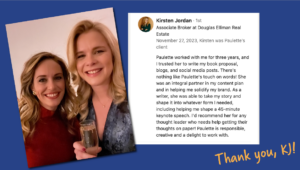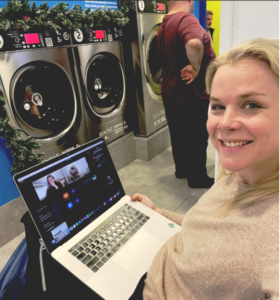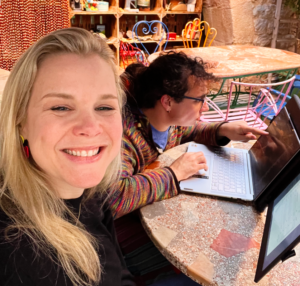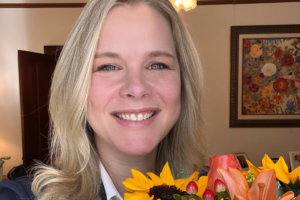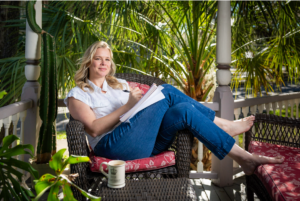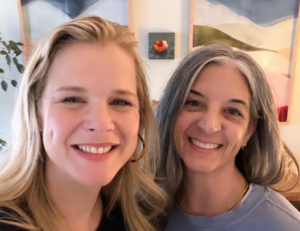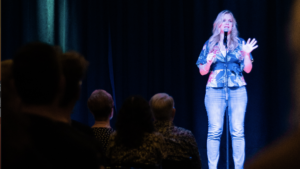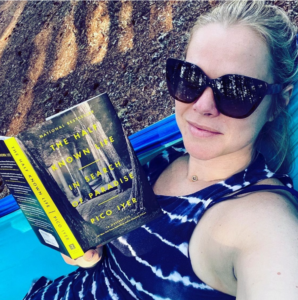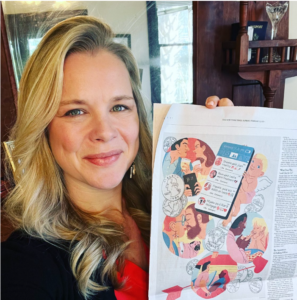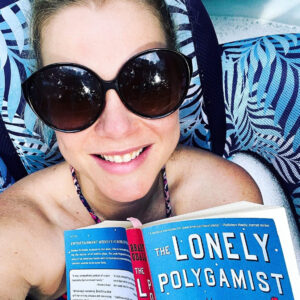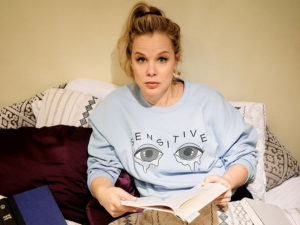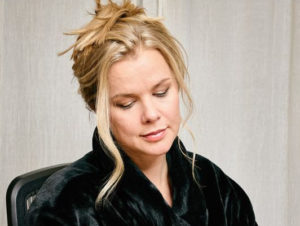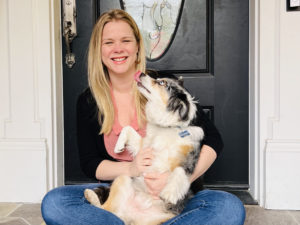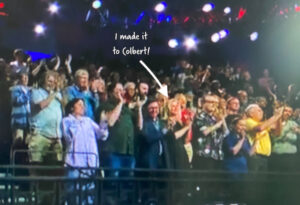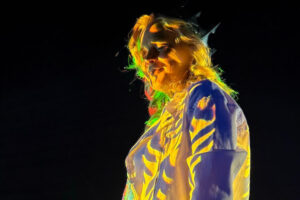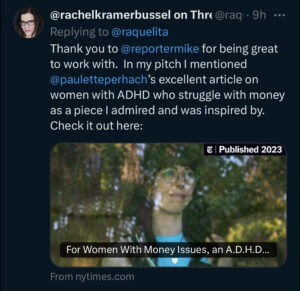Don’t do it, Paulette. Don’t press play. You know what’s going to happen.
But here you go again. Typing the title into that portal to the music you know will wrap around you, flow into you, tighten your heart.
This song is sad. And now you’re sad.
What is it about sad songs that makes us crave them?
Do we want to be sadder? Are we trying to prolong the pain? Or, just maybe, is there a glint of healing in sharing someone else’s sadness?
Psst: This site uses affiliate links.
The Ultimate Catharsis
Sitting in my tiny cubicle 10 years ago, it felt like there was nothing to do but get over him. Well, there was something else I could do… mentally belt Rihanna.
“I want you to stayyyyyy,” I’d mouth to the glow of my data entry computer screen.
Then the temp next to me would tap my shoulder and tell me about her low self-esteem and show me pictures of the man she loved.
She would cry. I would cry.
By the end of the song, we were the ones pounding on those keys. Sulking in our sadness, but letting it breathe, too.
Catharsis is the process of releasing repressed emotion. Purging it from our chests to let it roam free, and eventually, (hopefully?) drift away.
As writers, we aim to provide our readers their own sense of catharsis. But how do we do this without tipping over into sentimentality?
Sentimentality vs. Sentiment
It took me forever to understand what sentimentality is, because in the world of writing it’s different from how we talk about being sentimental in general.
IRL, I’m sentimental AF. I totally wanted my BFFs to have cool BFF necklaces with me in middle school! And I still lug my past from apartment to house to apartment, my middle school notes folded like paper footballs amid my photos and yearbooks.
But sentimentality in writing means something else. It means you’re trying to evoke an emotion, but you’re telling the reader how they’re supposed to feel, without putting in the work to make them feel that way. Think Hallmark cards.
It’s bad country songs. Cliché wedding poems. The worst romance novels.
It’s the difference between the middle school poem you wrote about your little broken heart and the song you choose to listen to as a grown-ass adult curled up in bed with your grown-ass broken heart.
Songs get to use the twin tools of melodies and words. Writers, our work is silent. We don’t have the E minor chord or the strain in our voice to express the feeling. Here’s what my favorite sad guys (and gals) have taught me about making them powerful.
Literary Lessons from My Favorite Sad Guy: Ray LaMontagne
My friend introduced me to Ray LaMontagne like 30 seconds after one of my worst breakups, and he became a lifetime favorite sad guy. He’s the MVSG on my Sad Guy with a Guitar and a Story to Tell playlist.
Here are the tools I hear him using over and over to make me sad:
Juxtaposition
“She lifts her skirt up to her knees, walks through the garden rows with her bare feet, laughing. I never learned to count my blessings, I choose instead to dwell in my disasters.”
Thus begins his song “Empty,” setting him this close to happiness, and showing how that makes it feel only so much further away.
You know what’s a sad song when you’re depressed? “Happy” by Pharrell. You try listening to that in 2015 when you’re going through a depressive episode, parked outside the mall and you try to not explode in ugly cry. That’s juxtaposition.
Simile
In Ray’s “Lesson Learned,” he recounts a scene where the singer’s love finds out he’s been with another woman.
“Well the truth, it fell so heavy, like a hammer through the room, that I could choose another over her.”
Damn. It’s so visual, and you also get to play on the subject of the simile and its connotations. Hammers can shatter.
“Now you hold me close and hard, but I was like a statue at most, refusing to acknowledge you’d been hurt.”
Statues are not only rigid physically, but also empty inside, seemingly human but not. The layers!
Similes are step-sisters with metaphors, but they use “like” or “as” to introduce them.
Metaphor
In “Burn,” it’s the singer (Ray) who’s been hurt, rather than the one doing the hurting. He tells her to “try to ignore, all this blood on the floor, it’s just this heart on my sleeve that’s bleeding.”
Notice there’s no “like” or “as,” but we get that there’s also no blood.
The best way to ruin a metaphor is to say, “the metaphorical…” before it. Let people get it and absorb it in their own way.
“Kiss him again,” he sings, “just to prove to me that you can. I will stand here, and burn in my skin. Yes I will stand here, and burn in my skin.”
Bleeding, burning. We know he’s just standing there, in emotional pain, but how much more do we feel it when he relates it to wounds of the body?
Imagery and Abstraction
“Cocaine flame in my bloodstream, sold my coat when I hit Spokane, bought myself a hard pack of cigarettes in the early morning rain. Lately my hands they don’t feel like mine, my eyes been stung with dust, I’m blind. Held you in my arms one time, lost you just the same.”
The opening lyric from Ray’s “Jolene” is just one of my favorite lyrics of any song out there in the world. Up there with Tom Petty’s “It was too cold to cry when I woke up alone, I hit my last number, I walked to the road.” (You know the one).
This opener is such a perfect wave of abstraction and imagery, ideas and details. The question of whether something is imagery, ask, Can I draw a picture of this? If you can’t, it’s most likely an abstraction.
Here it is again with abstraction in bold and imagery in italics.
“Cocaine flame in my bloodstream, sold my coat when I hit Spokane, bought myself a hard pack of cigarettes in the early morning rain. Lately my hands, they don’t feel like mine, my eyes been stung with dust, I’m blind, held you in my arms one time, lost you just the same.”
Some people call this the ladder of abstraction, but as I say in my book, I prefer to call it the buffet of abstraction. You usually want a plate with a variety of choices on it.
Although it’s not Ray, no discussion of sad songs would be complete without mentioning “Everybody Hurts,” by R.E.M., responsible for at least 45% of the Gross National Weeping in the 1990s. I remember in an interview Michael Stipe saying the song was about a very specific incident, but the words are actually quite general:
“When your day is long. And the night is yours alone. When you’re sure you’ve had enough. Don’t let yourself go. Everybody hurts sometimes. Sometimes everything is wrong. If you feel like letting go. If you think you’ve had too much. Take comfort in your friends.”
It has almost no imagery, nothing that could be drawn, and that’s how some pieces of art stand out, they go to one extreme. Sometimes you want only dessert on your plate. You could, in the same way, have a piece that’s entirely imagery.
Returning to “Jolene,” imagine if this section of the song, almost entirely imagery, set the tone for the rest of the song.
“I found myself face-down in a ditch, booze on my hair, blood on my lips, a picture of you, holding a picture of me, in the pocket of my blue jeans.”
Susan Orlean writes like this. She almost refuses to tell you what the details mean. The way she organizes them is her message.
For most pieces, I think a healthy mix works well.
Vulnerability
Let’s look again at “Burn,” where poor Ray is bleeding all over the kitchen, and where we have another technique that I see in so many sad songs: a kind of naked vulnerability that evokes sadness in the mere fact that someone is just so raw with emotions. It’s pathetic in the literal meaning, arousing pity.
“Oh mama, don’t walk away. I’m a god damn sore loser, I ain’t too proud to say. That I’m still thinking ’bout you, and I’m so lonesome without you, and I can’t get you out of my mind.”
Laying it all out there shows this person is just stripped of all pride, of the energy to keep up appearances. And we cling to it.
Blanket statements
There’s something kind of hopeless about blanket statements, beliefs about how things are, how we are, how the world is.
In “Empty” Ray asks, “Will I always feel this way? So empty, so estranged?”
Carol Dweck, the author of Mindset, would call this a fixed mindset. The opposite, the way we want to be, is in growth mindset, where we feel hopeful for growth and change. But we’re not in that space in sadness. In sadness, we’re so immersed in our pain that we’re blind to the existence of hope.
Blanket statements are expressions of hopelessness.
The Gift of Sadness
Sometimes it feels like the sadness fog will linger forever, repelling all joy, and sometimes plummeting even further into darkness. I just finished an essay, in fact, on surviving my own suicidal season.
“Will I always feel this way? So empty, so estranged?”
No, I wouldn’t. But I didn’t know that back then.
Writing about your darkness can be a way to finally get to the light, and to help someone else find it, too.
What artists have done for me, the sweet gift they’ve given me, is that they’ve opened themselves up, transferred their emotions to mine, and showed me they’re the same. They have ignited emotions in me to show me what the emotions feel like in them.
And in that, they’ve allowed me to know that I am not the only one walking around living a life shellacked on top of an inner experiences like a piece of armor.



